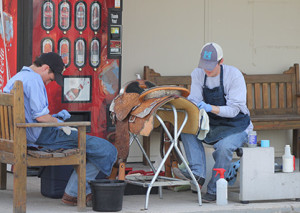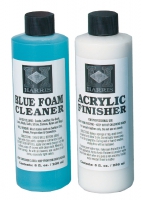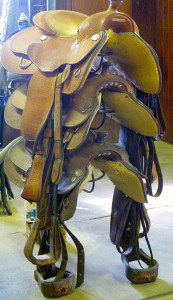Are You Ready for Winter? Final Section- Storing Show Tack
By: Megan Arzsman
Everyone knows that changes in weather can affect leather in many different ways. Heat and humidity can cause mold and mildew to collect under stirrup leathers while cold and dry conditions can cause leather to crack. You saved up for that dream saddle, so be sure you’re protecting your investment by storing your show tack appropriately during the winter.
Use a Keen Eye
After cleaning out your horse trailer for the winter, you might have simply stacked your saddles and bridles in the tack room, thinking they’ll be fine in their padded bags. Think again. Take a day to sit down and do a tack inventory. Look over every inch of material. Check for any signs of wear and tear that might make your next ride unsafe. Don’t forget to check your Chicago screws and stitches, which serve the important purpose of keeping your tack together.
If you don’t do so already, a good New Year’s Resolution is to start wiping down and inspecting your equipment after every ride. The leather experts at Harris Leather and Silverworks suggest using a compressed air or vacuum with a brush attachment to remove dust from their saddles after every show. Using a damp cloth to wipe down fenders and other sweaty parts of the saddle will help deter buildup.
Clean, Polish, Protect
Deep cleaning and conditioning doesn’t need to happen every weekend, but make it a habit to do so on a regular basis. A good time is during an extended break in the show schedule, such as this winter. Properly clean your entire saddle, bridle, and other tack by taking your equipment apart, piece by piece, and laying each component out on a clean, dry surface.
Every manufacturer should provide instructions on how best to care for, clean, and protect their products; it’s best to follow their suggestions as closely as possible. For example, Harris Leather offers their own product to clean their saddles and headstalls—the Harris Blue Foam cleaner. They recommend avoiding regular saddle soaps, since those tend to darken leather.
Saddle makers tend to agree on using Lexol NF as a conditioner for your leather. However, make sure you try the product on the underside of your leather to see if it will alter the color.
Silver cleaning can be a tedious process, but using a liquid cleaner and a clean toothbrush will help bring that sparkle back. Some suggestions from Harris include Goddard Silver Dip, Never Dull, and Wenol.
Some saddle brands, like Harris, suggest using a protective finish on your saddles to add a shine and refresh the look of the leather.
Storage
Once your saddle has been inspected, cleaned, and conditioned, it’s ready to be stored for the winter. Keep your equipment covered and protected from light and rodents; a quality saddle/bridle bag works best. However, don’t overpack the bags; you don’t want leather tack rubbing up against each other, which can create scuffs and scratches in the finish. Also, jamming everything into one bag can cause those pricey leather headstalls to become misshapen. Also, making sure your saddlebag fits properly is key.
Another best practice is to keep your tack in a climate-controlled area. If your tack room isn’t insulated, it’s best to keep tack inside the house so fluctuating exterior temperatures don’t wreak havoc on your leather. If you have a heater in your tack room, remember that warmth can be inviting to rodents, so take precautions to prevent an infestation.
Use a saddle stand to store your saddles. Bridle pieces should be hung so the crownpiece rests on a round hook to help keep its shape. (Do NOT prop up a saddle by using the horn or lay it flat on the ground.) Rawhide should be treated with special rawhide cream and stored in a plastic bin.
With the proper preparation, your tack will be ready for you to hit the show ring when spring rolls around, thus giving you a head start on a successful 2015 show season!














